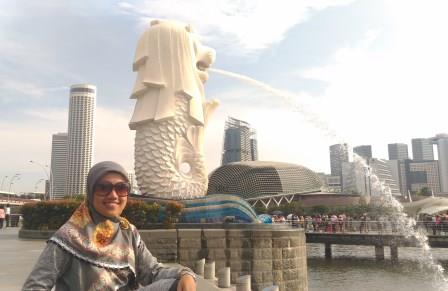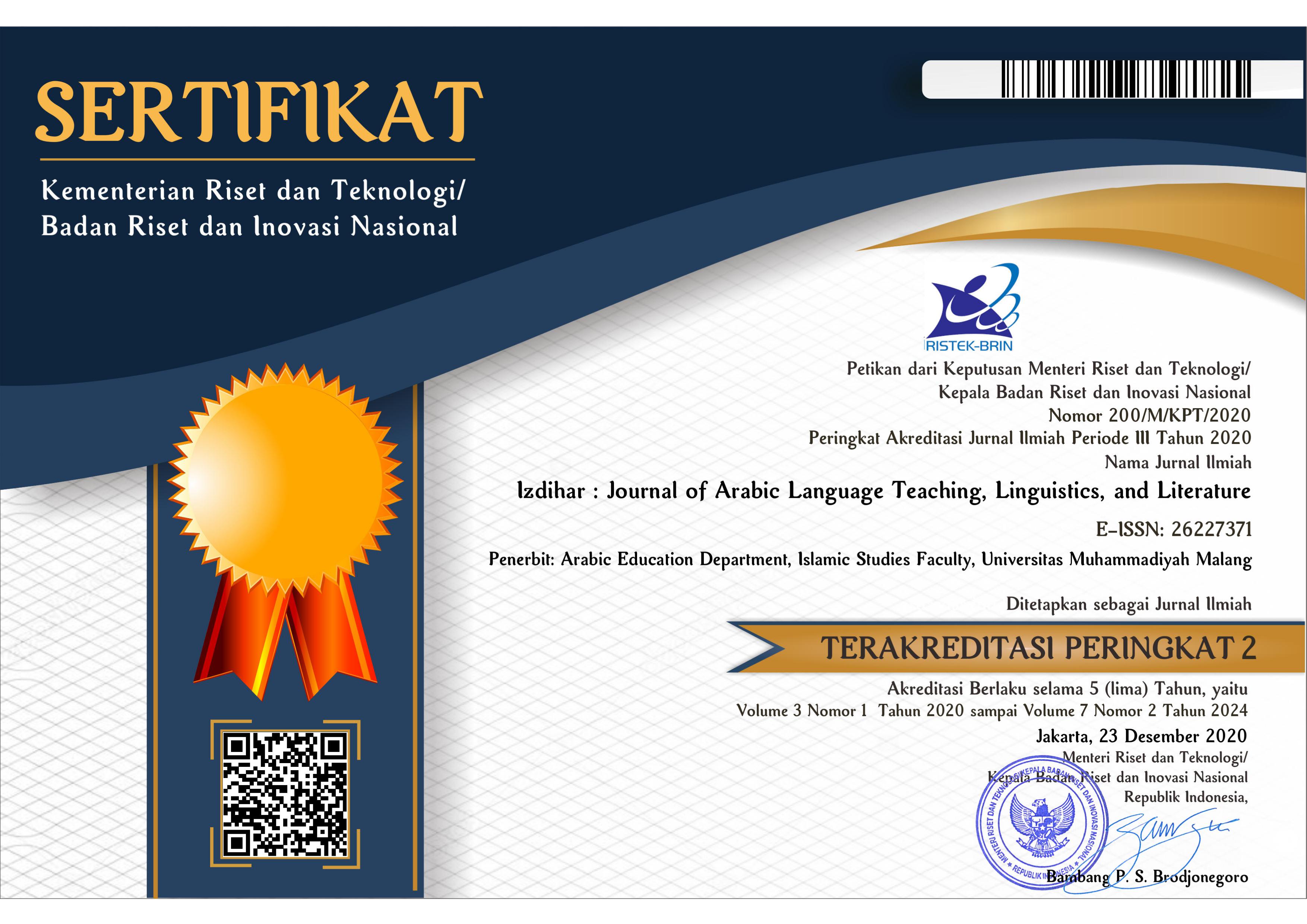Arabic Speaking Learning through Synchronous and Asynchronous Approaches
DOI:
https://doi.org/10.22219/jiz.v5i3.23265Keywords:
Learning, Pandemic, Speaking SkillAbstract
The purpose of this study was to this study aimed to describe the learning of Arabic speaking skill or maharah al-kalam (Kalam 1) through synchronous and asynchronous approaches in the pandemic era in terms of the process, media, evaluation, problems, and challenges in the Arabic Education Department, with a qualitative research approach. The approach in this study used descriptive qualitative with the type of research conducted in the form of case studies. Collecting data used were observation, interview, and documentation techniques. Analysis of the data used Miles, Huberman, and Saldana through the stages of data collection, data condensation, data display, and conclusion/verification. While the results obtained were the learning process using synchronous learning and asynchronous learning. The media used varies according to needs. Evaluation is in the form of oral and video recording. The problems experienced in the form of linguistic and non-linguistic, as well as challenges faced by academic and non-academic factors.
Downloads
References
Cetin, C., & Kara, A. (2020). Global Surveillance, Travel, and Trade During a Pandemic. Turkish Journal of Medical Sciences, 50(SI-1), 527–533. https://doi.org/10.3906/sag-2004-175
Dewi, R. S., Kultsum, U., & Armadi, A. (2017). Using Communicative Games in Improving Students’ Speaking Skills. English Language Teaching, 10(1), 63–71. https://doi.org/http://dx.doi.org/10.5539/elt.v10n1p63
Elihami, E., & Syahid, A. (2018). Penerapan Pembelajaran Pendidikan Agama Islam dalam Membentuk Karakter Pribadi yang Islami. Edumaspul: Jurnal Pendidikan, 2(1), 79–96. https://doi.org/https://doi.org/10.33487/edumaspul.v2i1.17
Erbolatovna, A. Z., & Izbaskanovna, S. S. (2020). Developing Speaking Skills In The Process Of Solving A Problem-Oriented Situation In English Lessons. International Scientific and Practical Conference (Apni.ru Редакционная Коллегия), 27–31. Retrieved from https://apni.ru/media/Sb_k-11.11.20.pdf#page=28
Fahmi, M. H. (2020). Komunikasi Synchronous dan Asynchronous dalam E-Learning Pada Masa Pandemic Covid-19. Jurnal Nomosleca, 6(2), 146–158. https://doi.org/https://doi.org/10.26905/nomosleca.v6i2.4947
Hamzah, A. (2019). Metode Penelitian Kualitatif. CV Literasi Nusantara Abadi (1st ed.). Literasi Nusantara.
Handayani, C., & Prasetyo, D. (2021). Learning Management System Berbasis Web (Studi Kasus: STIKOM Poltek Cirebon). Jurnal ICT: Information Communication & Technology, 19(2), 1–5. https://doi.org/https://doi.org/10.36054/jict-ikmi.v20i2.59
Hidayat, T. (2019). Pembahasan Studi Kasus Sebagai Bagian Metodologi Penelitian. Study Kasus. Retrieved from https://www.researchgate.net/profile/Taufik-Hidayat-32/publication/335227300_pembahasan_studi_kasus_sebagai_bagian_metodologi_penelitian/links/5d58b188299bf151badcdc65/pembahasan-studi-kasus-sebagai-bagian-metodologi-penelitian.pdf
Holidazia, R., & Rodliyah, R. S. (2020). Strategi Siswa dalam Pembelajaran Kosa Kata Bahasa Inggris. Jurnal Penelitian Pendidikan, 20(1), 111–120. Retrieved from https://pdfs.semanticscholar.org/c4e9/607f059461328f2619e7f5d74ebb3bc0ad99.pdf
Iswanto, R. (2017). Pembelajaran Bahasa Arab Dengan Pemanfaatan Teknologi. Arabiyatuna: Jurnal Bahasa Arab, 1(2), 139–152. https://doi.org/http://dx.doi.org/10.29240/jba.v1i2.286
Jubaidah, S., & Haq, M. E. S. (2020). Pengembangan Pembelajaran Kalam Berbasis Vlog Sebagai Alternatif Di Masa Pandemi. In Multaqa Nasional Bahasa Arab (Vol. 3, pp. 459–466). Retrieved from https://munasbauai.com/index.php/mnba/article/view/114
Lestari, M. I., & Anggraeni, D. (2021). Analisis Dampak Sentimen Masyarakat Selama Pandemi Covid-19 Terhadap Kurs Rupiah (Studi Kasus Pandemi Covid-19 di Indonesia). Jurnal EMBA: Jurnal Riset Ekonomi, Manajemen, Bisnis Dan Akuntansi, 9(1), 1–14. https://doi.org/https://doi.org/10.35794/emba.v8i4.31683
Lin, M.-H., & Chen, H. (2017). A study of The Effects of Digital Learning on Learning Motivation and Learning Outcome. Eurasia Journal of Mathematics, Science and Technology Education, 13(7), 3553–3564. https://doi.org/https://doi.org/10.12973/eurasia.2017.00744a
Lotfi, A. R., & Pozveh, S. M. H. H. (2019). The Effect of Synchronous and Asynchronous Language Learning: A Study of Iranian EFL Intermediate Students’ Vocabulary Learning. Theory and Practice in Language Studies, 9(12), 1585–1594. https://doi.org/http://dx.doi.org/10.17507/tpls.0912.16
Mei, L. L., & Masoumeh, A. S. (2017). An Analysis Of Factors Influencing Learners’ English Speaking Skill. International Journal Of Research In English Education, 2(1), 34–41. Retrieved from https://www.sid.ir/en/Journal/ViewPaper.aspx?ID=520992
Moorhouse, B. L., & Wong, K. M. (2021). Blending Asynchronous and Synchronous Digital Technologies and Instructional Approaches to Facilitate Remote Learning. Journal of Computers in Education, 1–20. https://doi.org/https://doi.org/10.1007/s40692-021-00195-8
Mubarak, M. R., Wahdah, N., Ilmiani, A. M., & Hamidah, H. (2020). Zoom Cloud Meeting: Media Alternatif dalam Pembelajaran Maharah Kalam di Tengah Wabah Virus Corona (Covid-19). Arabiyatuna: Jurnal Bahasa Arab, 4(2), 211–226. https://doi.org/10.29240/jba.v4i2.1445
Ngiwline, P., & Haruansong, P. (2020). The Effects of Using English Games to Develop Listening and Speaking Skills and Satisfaction towards English Studying of Grade 9 Students. In International Academic Multidisciplinary Research Conference In Lucerne (pp. 27–33). Retrieved from http://icbtsproceeding.ssru.ac.th/index.php/ICBTSLUCERNE2020/article/view/474
Ogbonna, C. G., Ibezim, N. E., & Obi, C. A. (2019). Synchronous Versus Asynchronous E-Learning in Teaching Word Processing: An Experimental Approach. South African Journal of Education, 39(2), 1–15. https://doi.org/10.15700/saje.v39n2a1383
Oktivianto, O. I., Hudaidah, H., & Alian, A. (2018). Pengaruh Implementasi Model Pembelajaran Role Playing dengan Media Film terhadap Motivasi Belajar Peserta Didik dalam Pelajaran Sejarah Materi Perang Palembang Kelas X di SMA Srijaya Negara Palembang. JP (Jurnal Pendidikan): Teori Dan Praktik, 3(2), 113–118. Retrieved from https://journal.unesa.ac.id/index.php/jp/article/view/2689
Prabowo, I. A., Setiyowati, & Remawati, D. (2021). Analisis Mekanisme Pembelajaran Daring Secara Sysnchronous dan Asysnchronous dimasa Pandemic Covid-19 di STMIK Sinar Nusantara. Jurnal Ilmiah SINUS, 19(1), 63–74. https://doi.org/http://dx.doi.org/10.30646/sinus.v19i1.524
Prananingrum, A. V., & Kholis, M. N. (2020). Whatsapp Sebagai Media Pembelajaran Bahasa Arab pada Masa Pandemic Covid-19. In Proceeding NATHLA: al-Nadwah al-’Alamiyyah fi Ta’lim al-Lughah al-’Arabiyyah (Vol. 1, pp. 129–136). https://doi.org/https://doi.org/10.23971/nathla.v1i1.166
Prawoko, I., Kristiantari, M. G. R., & Putra, I. K. A. (2019). Pengaruh Metode Bermain Peran Terhadap Peningkatan Keterampilan Berbicara Pada Anak Kelompok A Tk Handayani I Denpasar Barat Tahun Ajaran 2018/2019. Jurnal Pendidikan Anak Usia Dini Undiksha, 7(1), 47–56. https://doi.org/http://dx.doi.org/10.23887/paud.v7i1.18745
Sadiyah, H., & Alfian, I. (2021). Whatsapp Small Groups sebagai Media Pembelajaran Maharah Al-Kalam di Masa Daring. Arabia, 13(1), 1–22. https://doi.org/http://dx.doi.org/10.21043/arabia.v13i1.10217
Sehic, S. (2020). Redefining The Definition Of Learning From An Educational Aspect. IJIRR: International Journal of Information Research and Review, 7(6), 6940–6942. Retrieved from http://www.ijirr.com/sites/default/files/issues-pdf/3569.pdf
Silalahi, C. D. M., Sibarani, R., Setia, E., & Takari, M. (2020). Euphemism Found in Mangongkal Holi Tradition. In ISLLCE. https://doi.org/10.4108/eai.15-11-2019.2296206
Surico, P., & Galeotti, A. (2020). The Economics of a Pandemic: The Case of Covid-19. London: London Business School, 1–35. Retrieved from https://www.far.org.nz/assets/files/blog/files/3093ca6a-a676-568f-9e7c-5dc77c4e188f.pdf
Sya’diah, M., & Hamidah, H. (2021). Problematika Pembelajaran Maharah Kalam Melalui Video Conference dan Solusinya. Prosiding Pertemuan Ilmiah Internasional Bahasa Arab, 814–825. Retrieved from http://prosiding.imla.or.id/index.php/pinba/article/view/318
Thoyyibah, A. (2018). Film Sebagai Sarana Pendekatan Interkultural Dalam Pengajaran Bahasa Arab (Kajian Sosiolinguistik). In Multaqa Nasional Bahasa Arab (Vol. 1, pp. 1–11). Retrieved from https://munasbauai.com/index.php/mnba/article/view/11
Thoyyibah, A. (2019). Analisis Kesalahan Ortografi Bahasa Arab Mahasiswa Pendidikan Bahasa Arab Universitas Muhammadiyah Malang. Arabiyatuna: Jurnal Bahasa Arab, 3(2), 215–334. https://doi.org/http://dx.doi.org/10.29240/jba.v3i2.1017
Thoyyibah, A., & Eltoukhy, A. M. (2021). Comparative Analysis of Kaba, Al-’Ashri and Al-Bisri Dictionaries (Lexicography Studies). Izdihar: Journal of Arabic Language Teaching, Linguistics, and Literature, 4(1), 85–106. https://doi.org/https://doi.org/10.22219/jiz.v4i1.15792
Thoyyibah, A., & Firdaus, M. (2021). Implikasi Manajemen Sarana dan Prasarana Terhadap Pembelajaran Bahasa Arab (Studi Kasus Lab. Bahasa Arab FAI-UMM). Studi Arab, 12(1), 37–52. https://doi.org/https://doi.org/10.35891/sa.v12i1.2722
Tibahary, A. R., & Muliana, M. (2018). Model-Model Pembelajaran Inovatif. Scolae: Journal of Pedagogy, 1(1), 54–64. Retrieved from http://ejurnal.stkipdamsel.ac.id/index.php/scl/article/view/12
Tirtosari, T. (2020). Meningkatkan Kemampuan Mengajar Guru Melalui Teknik Supervisi Observasi Kelas Pada SMP Negeri I Puspo Kabupaten Pasuruan Tahun Pelajaran 2015/2016. Wahana Kreatifitas Pendidik (WKP), 3(2), 60–67. Retrieved from https://ejurnalkotamadiun.org/index.php/WKP/article/view/493
Downloads
Published
How to Cite
Issue
Section
License
Copyright (c) 2023 Anisatu Thoyyibah, Achmad Tito Rusady

This work is licensed under a Creative Commons Attribution-ShareAlike 4.0 International License.
Copyright Notice
Authors who publish with this journal agree to the following terms:
- Authors retain copyright and grant the journal right of first publication with the work simultaneously licensed under a Creative Commons Attribution-ShareAlike 4.0 International License that allows others to share the work with an acknowledgment of the work's authorship and initial publication in this journal.
- Authors are able to enter into separate, additional contractual arrangements for the non-exclusive distribution of the journal's published version of the work (e.g., post it to an institutional repository or publish it in a book), with an acknowledgment of its initial publication in this journal.
- Authors are permitted and encouraged to post their work online (e.g., in institutional repositories or on their website) prior to and during the submission process, as it can lead to productive exchanges, as well as earlier and greater citation of published work (See The Effect of Open Access).
Copyright (c) 2019 Izdihar : Journal of Arabic Language Teaching, Linguistics, and Literature

This work is licensed under a Creative Commons Attribution-ShareAlike 4.0 International License.


















